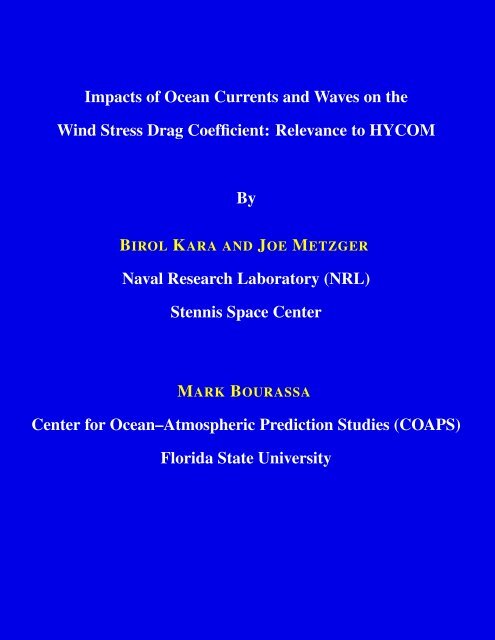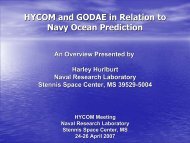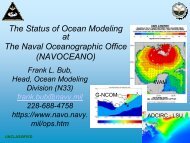Impacts of Ocean Currents and Waves on the Wind Stress ... - hycom
Impacts of Ocean Currents and Waves on the Wind Stress ... - hycom
Impacts of Ocean Currents and Waves on the Wind Stress ... - hycom
You also want an ePaper? Increase the reach of your titles
YUMPU automatically turns print PDFs into web optimized ePapers that Google loves.
<str<strong>on</strong>g>Impacts</str<strong>on</strong>g> <str<strong>on</strong>g>of</str<strong>on</strong>g> <str<strong>on</strong>g>Ocean</str<strong>on</strong>g> <str<strong>on</strong>g>Currents</str<strong>on</strong>g> <str<strong>on</strong>g>and</str<strong>on</strong>g> <str<strong>on</strong>g>Waves</str<strong>on</strong>g> <strong>on</strong> <strong>the</strong><br />
<strong>Wind</strong> <strong>Stress</strong> Drag Coefficient: Relevance to HYCOM<br />
By<br />
BIROL KARA AND JOE METZGER<br />
Naval Research Laboratory (NRL)<br />
Stennis Space Center<br />
MARK BOURASSA<br />
Center for <str<strong>on</strong>g>Ocean</str<strong>on</strong>g>–Atmospheric Predicti<strong>on</strong> Studies (COAPS)<br />
Florida State University
INTRODUCTION<br />
Surface ocean currents <str<strong>on</strong>g>and</str<strong>on</strong>g> waves influence <strong>the</strong><br />
wind stress drag coefficient as shown in <strong>the</strong> literature.<br />
• <str<strong>on</strong>g>Ocean</str<strong>on</strong>g> models have current speeds but typically <strong>the</strong>y<br />
do not include wave informati<strong>on</strong><br />
• <strong>Wind</strong> stress formulati<strong>on</strong> for input to HYCOM excludes<br />
both current <str<strong>on</strong>g>and</str<strong>on</strong>g> wave effects.<br />
We would like to answer two questi<strong>on</strong>s:<br />
(1) What is <strong>the</strong> impact <str<strong>on</strong>g>of</str<strong>on</strong>g> currents <str<strong>on</strong>g>and</str<strong>on</strong>g> waves <strong>on</strong> <strong>the</strong> drag?<br />
(2) Are <strong>the</strong>se effects negligible over <strong>the</strong> global ocean?
WIND STRESS FORMULATION<br />
• <strong>Wind</strong> stress (τ ) is parameterized as<br />
τ = ρa CD V 2<br />
• Thus, τ depends <strong>on</strong><br />
o (1) density <str<strong>on</strong>g>of</str<strong>on</strong>g> <strong>the</strong> air: ρa<br />
o (2) drag coefficient: CD<br />
o (3) squared wind speed V 2<br />
• ρa <str<strong>on</strong>g>and</str<strong>on</strong>g> V are well-known but CD is NOT.
• CD depends <strong>on</strong><br />
DRAG COEFFICIENT<br />
o dynamic stability at <strong>the</strong> air–sea interface, i.e.<br />
o air–sea temperature difference, <str<strong>on</strong>g>and</str<strong>on</strong>g><br />
o relative humidity at <strong>the</strong> air–sea interface<br />
• HYCOM includes preceding effects (full stability)<br />
• CD also depends <strong>on</strong> <strong>the</strong> sea state<br />
sea surface current speed<br />
ocean wave speed<br />
Our focus is <strong>on</strong> <strong>the</strong> effects <str<strong>on</strong>g>of</str<strong>on</strong>g> sea state!
v<br />
0.9<br />
DRAG COEFFICIENT <strong>on</strong> 1 Aug 2005 (00Z)<br />
1.0<br />
• CD × 10 3 is<br />
1.1<br />
180W 90W 0 90E<br />
1.2<br />
1.3<br />
1.4<br />
1.5<br />
1.6<br />
1.7<br />
60N<br />
60S<br />
v<br />
30N<br />
Eq<br />
30S<br />
o based <strong>on</strong> polynomial equati<strong>on</strong>s (Kara et al. 2005),<br />
o based <strong>on</strong> <strong>the</strong> COARE (v3.0) algorithm, <str<strong>on</strong>g>and</str<strong>on</strong>g><br />
o formulated using air–sea stability.<br />
NOTE: <str<strong>on</strong>g>Currents</str<strong>on</strong>g> <str<strong>on</strong>g>and</str<strong>on</strong>g> wave speeds are NOT included in CD.
METHODOLOGY<br />
• We would like vector averages <str<strong>on</strong>g>of</str<strong>on</strong>g><br />
�V − �<br />
VC − �<br />
VW<br />
• Drop vector notati<strong>on</strong> for simplicity<br />
o <strong>Wind</strong> speed at 10 m: V<br />
o Surface current speed: VC<br />
o Primary wave speed: VW<br />
• Use z<strong>on</strong>al <str<strong>on</strong>g>and</str<strong>on</strong>g> meridi<strong>on</strong>al comp<strong>on</strong>ents for V, VC <str<strong>on</strong>g>and</str<strong>on</strong>g> VW
• Data sources:<br />
o V from 1 ◦ NOGAPS<br />
GLOBAL DATA<br />
o VC from 1/12 ◦ HYCOM<br />
o VW from 1 ◦ WW3 model<br />
• NOGAPS winds are used because<br />
o (1) its resoluti<strong>on</strong> is c<strong>on</strong>sistent with WW3, <str<strong>on</strong>g>and</str<strong>on</strong>g><br />
o (2) it provides 3 hourly data (important for stability)<br />
Note: We apply 1 ◦ binning to VW for c<strong>on</strong>sistency.<br />
NOGAPS: Navy Operati<strong>on</strong>al Global Atmospheric Predicti<strong>on</strong> System<br />
HYCOM: HYbrid Coordinate <str<strong>on</strong>g>Ocean</str<strong>on</strong>g> Model<br />
WW3: Wave Watch 3, a third generati<strong>on</strong> wave model
SIGNIFICANT WAVE HEIGHT FROM WW3<br />
><br />
6<br />
(a) 1 Aug 2005 (00Z)<br />
(b) Aug 2005 Mean<br />
4<br />
2<br />
0<br />
(m)<br />
These are needed for wave speed calculati<strong>on</strong>.
CALCULATION OF WAVE SPEED<br />
V − VC − VW<br />
• V <str<strong>on</strong>g>and</str<strong>on</strong>g> VC are directly obtained (NOGAPS <str<strong>on</strong>g>and</str<strong>on</strong>g> HYCOM)<br />
• However, VW has to be calculated (WW3)<br />
• VW is calculated following Bourassa (2006)<br />
VW = f Vorb<br />
Vorb = 3.14 H/T<br />
f is c<strong>on</strong>stant (0.8), <str<strong>on</strong>g>and</str<strong>on</strong>g><br />
Vorb is <strong>the</strong> orbital velocity<br />
significant wave height (H)<br />
dominant wave period (T )
VW (m s −1 )<br />
1.6<br />
1.2<br />
0.8<br />
0.4<br />
0<br />
> VC (m s −1 )<br />
0.8<br />
0.6<br />
0.4<br />
0.2<br />
0<br />
> V (m s −1 )<br />
16<br />
12<br />
8<br />
4<br />
0<br />
(a) 1 Aug 2005 (00Z) (b) Aug 2005 Mean<br />
FIELDS USED FOR CALCULATIONS
V − VW<br />
V − VW − VC<br />
(%)<br />
PERCENTAGE CHANGES (1 Aug 2005)<br />
V − VC (a) Daily wind change: ∆V (b) Daily drag change: ∆CD<br />
< -20 -15 -10 -5 0 5 10 15 20 < < -8 -6 -4 -2 0 2 4 6 8 <<br />
VC/VW/VC+VW reduces V by 1.0%/5.4%/6.4% globally<br />
VC/VW/VC+VW reduces CD by 0.3%/1.7%/1.9% globally
V − VW<br />
V − VW − VC<br />
(%)<br />
PERCENTAGE CHANGES (Aug 2005 mean)<br />
V − VC (a) M<strong>on</strong>thly wind change: ∆V (b) M<strong>on</strong>thly drag change: ∆CD<br />
< -20 -15 -10 -5 0 5 10 15 20 < < -8 -6 -4 -2 0 2 4 6 8 <<br />
VC/VW/VC+VW reduces V by 1.4%/5.5%/6.9% globally<br />
VC/VW/VC+VW reduces CD by 0.4%/1.7%/2.1% globally
CONCLUSION<br />
• Spatial variability in CD DOES exists<br />
o HYCOM already includes this variability<br />
o <strong>Wind</strong> speed, air–sea temp, relative humidity<br />
• CD should also include current <str<strong>on</strong>g>and</str<strong>on</strong>g> wave effects<br />
o Current speed: available at each model time step<br />
o Wave speed: what do we do about that?<br />
o a statistical relati<strong>on</strong>ship may be developed<br />
• Globally, combined outcome <str<strong>on</strong>g>of</str<strong>on</strong>g> wind <str<strong>on</strong>g>and</str<strong>on</strong>g> wave speed:<br />
o Reducti<strong>on</strong> in CD by 2% <strong>on</strong>ly<br />
o However, <strong>on</strong>e must note daily spatial variability<br />
o western boundary currents (current speed)<br />
o high latitudes (wave speed)






